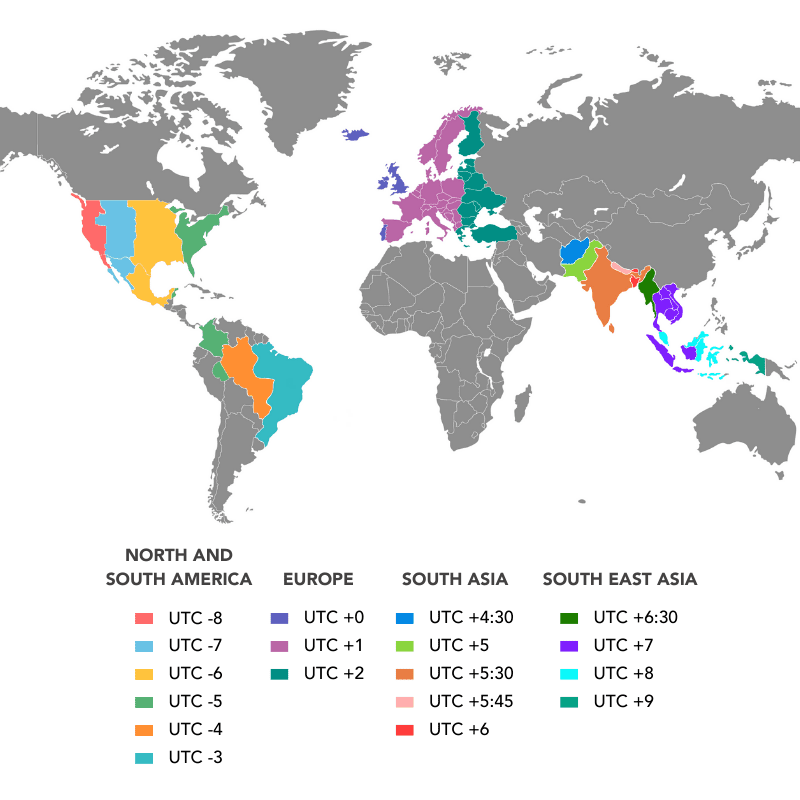
Today, outsourcing is no longer a strange or obscure tactic used by a handful of companies, it has become a regular strategy employed to utilize resources effectively and obtain more with less. Working in different time zones is often par for the course for many remote tech teams.
We’ve all heard the saying that all companies are now tech companies. This great transition or great digitalization (as it is often called) means that tech teams are more common than ever across companies in all industries. It’s not just tech. In manufacturing, healthcare, and finance, software developers and engineers are needed to build and maintain infrastructure to improve these services. Most companies today are dependent—to some degree or other—on technology applications or delivering a solution or product through technology. So everyone is looking to build a great tech team that can enable them to do that, with a big part of them opting for outsourcing.
Companies choosing to outsource are faced with a decision: should I outsource to South Asia, Eastern Europe, Latin America, or elsewhere?
In addition to the economic, social, and cultural differences that exist among all of these regions, there is one essential difference that can have a bigger impact than first meets the eye. Sometimes that one factor is so critical that it makes or breaks a companies productivity or workflow. Let’s look at it below.
Same Time Zone Outsourcing to the US
Outsourcing locations that share a similar time zone with the U.S. include Latin American countries like; Mexico, Costa Rica, Colombia, and some parts of Brazil. With the majority of the overlap happening in the Central and Eastern time zones. Note that Mexico is the only Latin American country that shares Pacific, Mountain, Central, and Eastern time zones with the US.
Advantages of same time zone outsourcing
- Having the same time zone allows for real-time collaboration and communication between the head office and the outsourced tech team or IT agency.
- It allows for quick resolution of questions, problems, or changes in direction with nearshore engineers
- Reduces the need for super early meetings or super late nights. In essence, it reduces the need to coordinate meetings too much time in advance.
- Socializing between teams becomes more organic and natural.
- There’s less of a chance that work is overlooked as it’s handed off.
- Same time zone means proximity, which in turn means that if travel is necessary, it should be a short trip.
- While not necessarily true for every location in the same time zone, countries that are close to the US – like Mexico – boast cultural similarities that can also result in increased productivity and efficiency.
Today’s communication tools such as Slack, Zoom, and Google Meet have provided an arsenal of collaboration for remote tech teams. Even when they are spread out across geographical regions, having some consistency with time zones makes it easy to schedule impromptu meetings, chats, sharing of documents and so forth, that improve efficiency, team collaboration, and project management.
One Shift Time Zone Difference to the US (+5 to +10 hours)
Outsourcing locations with one shift time zone difference to the U.S. include European countries like; Ukraine, Romania, and Poland. The difference in time zone range from five hours ahead all the way to ten hours ahead of the U.S. depending on the location. The most common time difference is being 7 hours ahead.
Advantages of one shift time zone outsourcing
- If systems and procedures are implemented, it allows for continuous development work to be done for ¾ of the 24-hour day.
- With a single shift in overlap, communication and collaboration is limited, but can still happen in real-time with offshore engineering teams
- Resolution of problems, questions, and changes in direction can happen most of the time, with the only exceptions being early during the US day.
- Most of the time there’s always someone online, this works great for companies outsourcing tech support teams, they can cover a wider range of time zones.
- Socializing between teams is still organic, although it might feel rushed
Two Shift Time Zone Difference to the US (+10 to +15 hours)
Outsourcing locations with two shift time zone difference to the US include South and Southeast Asian countries like; India, the Philippines, and Vietnam. The difference in time zone ranges from ten hours ahead all the way to fifteen hours ahead of the US depending on the location. The most common time difference being 14 hours ahead.
Benefits of one shift time zone outsourcing
- There’s always someone online, this is especially helpful if you’re looking to provide 24/7 customer support services
- Increased productivity with continuous workflow – an offshore development team in this time zone means there’s around the clock work being completed.
The Takeaway

IT support is critical for small as well as multinational businesses. By outsourcing a proficient IT team from various countries, organizations can benefit from flexible timings, budget-friendly costs, and adept workers. On the flip side, time zones may lead to delays in communication and, ultimately, failure to complete a project on time.
Thus, to ensure an effective and reliable IT team, businesses need to choose wisely by setting precise requirements, visualizing overlap hours, setting up effective communication methods, and fixing appropriate meeting times. Coming up with guidelines for working across time zones (even when there is a one or two hour difference) can make a difference between a team that syncs up together nicely and one that is jagged and stalls its own communication. Some of these remote guidelines can include:
- Setting up meeting blocks for allowed meeting times
- Aligning work times as much as possible
- And having internal guidelines around flexibility or unique circumstances.
Find Remote Tech Talent in the Same Time Zones
Given the rapid rise of remote work in regions like Latin America, many companies have found that finding talent in these regions is easier than ever. Not only does the region provide access to top talent trained in the most in-demand technologies and skills but it takes advantage of proximity and same time zones to make productivity, collaboration, and creativity easier.
Learn more about how to tap into Mexico’s growing talent pool.


